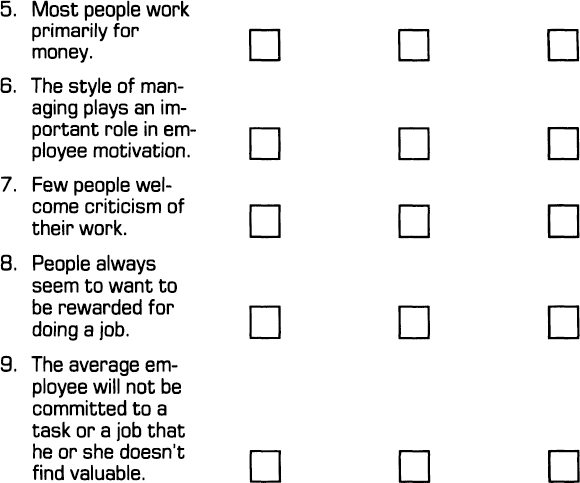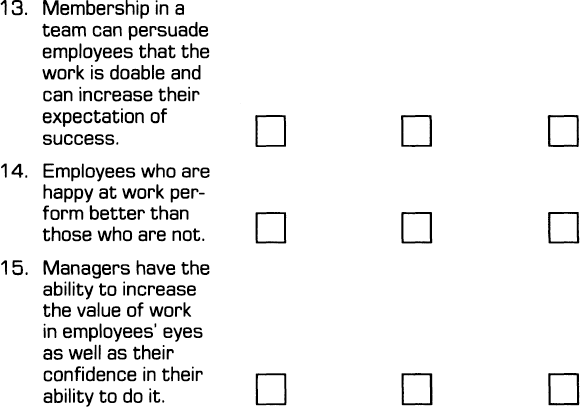![]()
CHAPTER 6
HELPING TEAM MEMBERS BUILD COMMITMENT
To get the commitment of your people to the objectives you want to achieve, you must understand what they want to get out of their work and their association with you. You need to understand what motivates people at work to do a good job. And the first reality is that you do not and cannot motivate them. We all motivate ourselves and no one else.
When a team outgrows individual performance and learns team confidence, excellence becomes a reality.
—JOE PATERNO
HEAD FOOTBALL COACH, PENN STATE UNIVERSITY
There is a motivation theory that provides a universal key to what motivates people to be productive on the job: expectancy theory. It is mainstream psychology; it is simple and practical; and it works. Expectancy theory explains that people, given choices, choose the option that promises to give them the greatest reward. In the simplest terms, when you have, say, three choices, you’ll choose the one that provides you with the result you value the most. The theory applies to the career you select, the car you buy, the task you start the day with, what you order for lunch, where you go on vacation, and so on.
However, when you make your choice, you must be reasonably sure that the reward you are looking for can be attainable without undue risk or effort. In short, you must have a reasonable expectation of getting what you want (that’s where the expectancy comes in). To illustrate: You shop for a new television. Since you like sports, you’d like to see the games on a wide-screen TV. But when you look at the prices for large sets, you realize that to spend so much money on a new wide-screen set would put your cash position in jeopardy for a time. As much as you want the big screen, you don’t like putting yourself at risk. So you settle for a smaller set and a lesser expenditure.
Rewards are very important to people at work. It’s a myth that most people work primarily for money. Most people would say that they value interesting work, challenge, and advancement opportunities over money. Actually—and this is an important consideration for managers—there are two areas in which people find value in their work: the achievement of goals that they have set for themselves internally, and the attainment of objectives that their managers provide them. As motivators, the internal rewards are probably more powerful. For example, people may work for achievement and its varied benefits: the satisfaction of accomplishing things, status, self-esteem, and social rewards. Some employees get very turned on by being part of a group of people they like. Growth and advancement are powerful motivators. For most people, it’s very appealing to increase skills, competence, and knowledge so that they know they are better at what they do this year than they were last.
As manager, you can take advantage of your employees’ internal reward drives if you can help them find a way to achieve their personal goals (such as a sense of achievement) through helping you achieve your organizational goals. For example, you seek to have a team working for you, because you believe that a team can be more productive than an aggregate of individual employees. Some of your employees respond to being part of a group because they have high social needs. The psychologist terms these affiliation needs. These people like to be part of a congenial, successful group, so they find increased motivation in being part of your team.
SELF-ASSESSMENT: WHAT MAKES PEOPLE WORK WELL?
Indicate next to each statement whether you agree with it, disagree with it, or are uncertain.



ANALYZING YOUR SELF-ASSESSMENT
1. Agree. You didn’t have any problem with this, did you? People whose work is not very important over the long run usually do just what they have to do to keep their jobs, and not much more.
2. Disagree. There’s no such person. Everyone is motivated, but not everyone is automatically motivated to do what his or her manager wants. The answer for managers is to make the work rewarding and doable.
3. Uncertain. Some people work at what they don’t like to do—for a time. Then the extra energy required to do something they dislike becomes a price they may not be willing to pay. And they probably won’t do the job very well while they do it. People work best at what they like to do.
4. Agree. According to research, if you show that you expect your people to do a good job, they are more likely to produce good work than if you expect mediocre performance.
5. Disagree. In employee surveys, money is usually fourth or fifth on the list. Most people find challenge, interesting work, growth, and advancement more important than money.
6. Uncertain. No one style is effective with everyone. And there are some managers with a “nice” style who get poor results from people. The main thing people look for is a manager who helps them achieve what is important to them through their work. If you wish to have an effective team, however, it does help immensely for you to have a participative style—to be willing to share your leadership.
7. Disagree. If criticism is necessary to do the job right, people accept it, even if it is painful. Receiving criticism to correct failings is better than floundering or fumbling, which few people are happy doing. Most people want to be successful at what they do.
8. Agree. People do what they feel rewarded for doing. That’s human nature.
9. Agree. That doesn’t mean that people won’t do the work. Rather, they won’t be committed, and probably, over the long haul, they won’t be very good at it.
10. Agree. You can increase the value of the work by making it more important to employees.
11. Agree. Since you are the key to the motivation of employees, you should have no trouble agreeing that your managing has much to do with the motivation your people feel.
12. Agree. Expectation of being successful and enjoying the reward for doing the work are central to motivation. If employees don’t see the job as doable, they won’t want to tackle it.
13. Agree. In an effective team, peers can supply support and help, both of which can increase employees’ confidence that the work is doable.
14. Uncertain. Employees who feel rewarded perform better than those who don’t. All we know about happy people is that they are happy; they don’t always do better work.
15. Agree. Managers play a crucial role in promoting employee self-confidence and interest in their work.
When your employees have been successful—have performed well for you—you can then supply the external rewards, such as money, praise, promotion, more interesting work, and the like.
PRESCRIPTION FOR GREATER MOTIVATION
You can build value into people’s work, and you can increase their expectation that they can be successful in attaining the rewards they want, by following these five steps based on expectancy theory:
Five Steps for Building Value In to People’s Work
1.Tell people what you expect them to do. On a regular, periodic basis, tell employees what your goals are as well as your standards of performance. People need goals. There isn’t any human activity without them. Don’t assume that they know what you want. Tell them as specifically as possible.
2.Make the work valuable. When you can, assign people to the kinds of work they like and can do well—work that they regard as valuable to them. Give them work that enables them to achieve their personal goals, such as growth, advancement, self-esteem, professional recognition, status, and the like.
3.Make the work doable. Increase employees’ confidence that they can do what you expect by training, coaching, mentoring, listening, scheduling, providing resources, and so on.
4.Give feedback. When employees try to do what you expect, give them feedback on how well they are doing. Positive feedback tells them what they need to continue doing; criticism helps them correct mistakes.
5.Reward successful performance. When employees have done what you asked them to do, reward them with both monetary and nonmonetary recognition.
EFFECTIVE GOAL-SETTING PRACTICES
![]() I try to have goal-setting sessions at least once a year with all my employees as individuals, and with each team as necessary.
I try to have goal-setting sessions at least once a year with all my employees as individuals, and with each team as necessary.
![]() When possible, I invite employees to join with me in setting worthwhile goals for the department.
When possible, I invite employees to join with me in setting worthwhile goals for the department.
![]() With employees whose performance is reliable, I often leave it to them to determine the methods they will use to reach their goals.
With employees whose performance is reliable, I often leave it to them to determine the methods they will use to reach their goals.
![]() I invite employees to set personal goals for their growth and advancement.
I invite employees to set personal goals for their growth and advancement.
![]() I try to know what employees want out of their work, and what their needs and goals are.
I try to know what employees want out of their work, and what their needs and goals are.
![]() Once I have agreed on a goal, I make sure it is addressed.
Once I have agreed on a goal, I make sure it is addressed.
![]() I let employees know at the time of setting goals how important they are to me.
I let employees know at the time of setting goals how important they are to me.
![]() I usually incorporate goals in appraisals.
I usually incorporate goals in appraisals.
![]() I make sure to find out how realistic the goals are to employees who are charged with reaching them.
I make sure to find out how realistic the goals are to employees who are charged with reaching them.
![]() I make sure periodically that all employees understand not only my goals but the performance standards I expect of them.
I make sure periodically that all employees understand not only my goals but the performance standards I expect of them.

